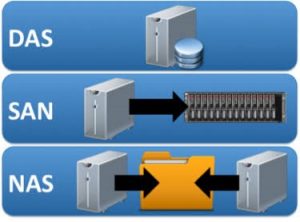
What are SAN and NAS? What’s the difference between SAN & NAS? Which is costlier SAN or NAS? Where is the disadvantage of SAN?
Major Difference Between SAN & NAS Technology

A storage area network (SAN) provides access to block level data storage. These are primarily used to enhance storage devices such as tape libraries, disk arrays, and optical jukeboxes and make them accessible to a server so that they appear to be a locally attached device. A network-attached storage (NAS) is a computer data storage server that is a connection to a network providing access to data to a large group of clients. The difference is found in how they are cabled and how they are connected to the system. SAN is costlier than NAS due to the fiber cabling cost. The disadvantages are the cost, and the complexity and the hardware are quite expensive also.

Major Difference Between SAN & NAS Technology

SAN stands for Storage-Area Network. It is a dedicated high-speed network or subnetwork that presents and connects shared pools of storage devices to numerous servers. It moves storage resources out of the common user network and re-organizes them into a self-sufficient, high performance network. This allows every server to access shared storage as if it was a drive directly connected to the server.
SAN is normally assembled using three main components: switches, cabling, and HBAs or host bus adapters. Every storage system and switch on the SAN must be interconnected and the physical connections should support bandwidth levels that can sufficiently handle peak data activities. NAS, on the other hand, stands for network-attached storage.
This is the type of dedicated file storage that gives local area network nodes with file-based shared storage using a standard Ethernet connection. NAS devices normally don’t have display or keyboard. They are configured and managed using a browser-based utility application.














